From tiny teacups to miniature cities, humans have an irresistible fascination with small-scale versions of the world. Social media feeds overflow with tiny cooking videos, model railroads, and micro art that captures entire scenes in the palm of a hand. There’s something universally satisfying about seeing the familiar reduced to adorable proportions. But why does “mini” make us so happy?
Psychologists and neuroscientists believe our love for miniatures taps into deep cognitive and emotional instincts. It’s part nostalgia, part control, and part wonder at craftsmanship.
The Psychology of the Small
Miniatures trigger a sense of awe and mastery. When we encounter something small yet perfectly detailed, our brains recognize both the complexity of the real-world object and the precision required to shrink it. This dual awareness delights us. It’s like seeing the impossible made tangible.
Research in cognitive psychology shows that humans enjoy “cognitive compression,” or the satisfaction of seeing large systems simplified into smaller, understandable versions. A tiny dollhouse or scale model allows our minds to grasp the whole picture at once, something that’s impossible in full-sized reality.
There’s also an element of control. Mini worlds are safe and predictable, allowing us to experience mastery over environments that might otherwise feel overwhelming. Children use toys to explore big ideas, such as home, travel, family, and adventure. Adults use miniatures as symbols of comfort and order in a chaotic world.
Explore The Tiny Computers Inside Everyday Objects to see how small tech quietly runs our world.
Nostalgia and Emotional Connection
Our fascination with small things also connects deeply with nostalgia. Miniatures often remind us of childhood play, when imagination could shrink or expand reality at will. Seeing a tiny kitchen or toy-sized car can awaken powerful emotional memories tied to innocence and creativity.
There’s also a biological cue at work. Studies on “cuteness” show that humans instinctively respond to smallness—large eyes, rounded shapes, and proportionally big heads trigger caregiving instincts. That’s why we find kittens, babies, and even cartoon characters adorable. Mini objects hijack that same circuitry, making us feel affection and protectiveness toward inanimate things.
Art historians note that miniatures have long been associated with sentimentality and memory. From ancient Egyptian figurines to 18th-century portrait lockets, small-scale art was often designed to be held close, symbolizing intimacy. Even today, a tiny keepsake or handcrafted model can evoke a sense of personal connection that larger, impersonal objects do not.
Check out What Your Favorite Seat on the Couch Says About You to explore everyday comfort and control.
The Modern Miniature Renaissance
In the digital age, our love for miniatures has only intensified. Mini cooking videos, model builders, and tiny sculpture artists thrive on platforms like TikTok and Instagram, where short, detailed content satisfies our craving for both craftsmanship and calm. Watching someone build or arrange a miniature scene delivers the same psychological reward as watching a puzzle solved or a story completed.
Sociologists suggest this trend also reflects a cultural yearning for simplicity. Miniatures represent a scaled-down, idealized world—neat, manageable, and free from clutter. In an era of global stress and digital overload, that smallness feels soothing.
Ultimately, miniatures remind us of our human desire to understand and nurture the world around us. Whether it’s a tiny garden on a desk or a meticulously painted figurine, these little worlds reflect our longing for connection, order, and wonder—all contained within something we can hold in our hands.
Browse Why ‘Old’ Technology Is Suddenly Cool Again for a quick look at trend-driven nostalgia.




